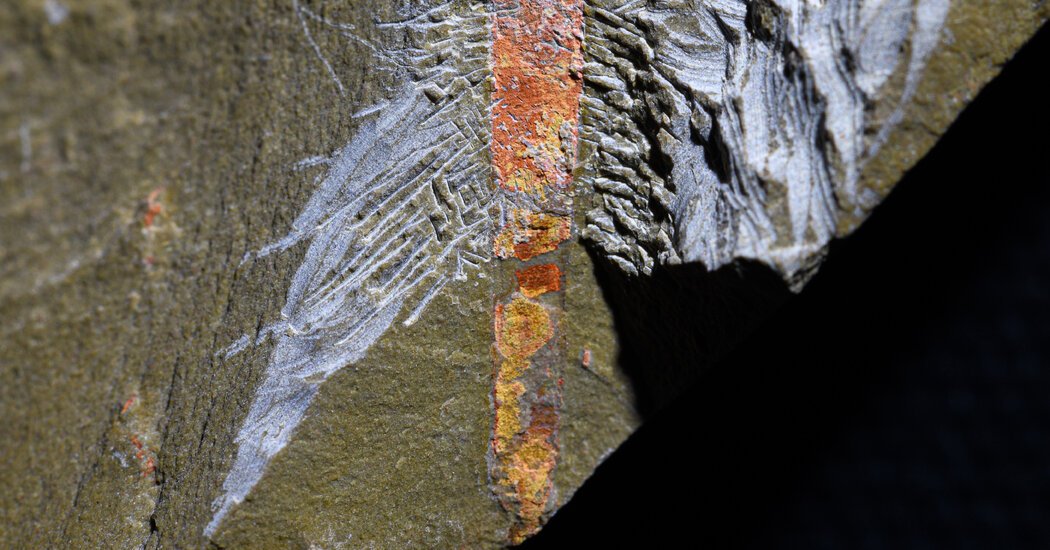With a head covered in rows of curved spines, ancient Selkirkia worms could easily be confused with the razor-toothed sandworms that inhabit the deserts of Arrakis in “Dune: Part Two.”
During the Cambrian Explosion more than 500 million years ago, these weird worms — which lived inside long, cone-shaped tubes — were some of the most common predators on the seafloor.
“If you were a small invertebrate coming across them, it would have been your worst nightmare,” said Karma Nanglu, a paleontologist at Harvard. “It’s like being engulfed by a conveyor belt of fangs and teeth.”
Thankfully for would-be spice harvesters, these ravenous worms disappeared hundreds of million years ago. But a trove of recently analyzed fossils from Morocco reveals that these formidable predators measuring only an inch or two in length, persisted much longer than previously thought.
In a paper published today in the journal Biology Letters, Dr. Nanglu’s team described a new species of Selkirkia worm that lived 25 million years after this group of tube-dwellers was thought to have gone extinct.
The newly described tubular worms were discovered when Dr. Nanglu and his colleagues sifted through fossils stored in the collection of Harvard’s Museum of Comparative Zoology. The fossils hail from Morocco’s Fezouata Formation, a deposit dating back to the Early Ordovician period, which began around 488 million years ago and spanned nearly 45 million years. This was a dynamic era when holdovers from the Cambrian rubbed shoulders with evolutionary newcomers like sea scorpions and horseshoe crabs.
The Fezouata Formation offers a detailed snapshot of that ecological transition. The site is well known for the remains of sea creatures like trilobites, which are often preserved in rusty shades of red and orange. Some of the preserved critters even retain delicate soft tissue features that rarely fossilize. Most research on Fezouata fossils has focused on these remarkable finds, overlooking the vast amount of what Dr. Nanglu calls “fossil bycatch” — the smaller remains and fragments also contained in Fezouata rocks.
As the team combed through the museum’s specimens, they noticed several fiery-hued fossils of tapering tubes that looked like elongated ice cream cones. The ringed textures of these tubes, which measured only an inch long, were nearly identical to Selkirkia fossils from much older Cambrian deposits like the Burgess Shale.
“We don’t expect this guy to be around any more,” Dr. Nanglu said. “It’s 25 million years out of place.”
A closer analysis confirmed that the tubes belonged to a new species of Selkirkia worm. They gave the new animal the species name tsering, which is from the Tibetan word for “long life.” The new species not only expands the temporal record of Selkirkia worms, it also confirms that they lived in environments closer to the South Pole, where Morocco was situated during the Ordovician period.
According to Jean-Bernard Caron, a paleontologist at the Royal Ontario Museum in Toronto who was not involved in the new paper, this discovery highlights that some Cambrian creatures were able to persist even as diversity exploded in the Ordovician era.
“This new study adds to a growing body of evidence that many members of Cambrian communities continued to thrive during the following Ordovician period and were not quickly replaced as previous evolutionary models might have suggested,” he said.
According to Dr. Caron, the new worm’s morphology “appears remarkably unchanged compared to its Cambrian counterpart.” This suggests that Selkirkia worms experienced little evolutionary change over the 40 million years they spent devouring other seafloor inhabitants.
But their tube-based body form eventually went out of evolutionary style among closely related worms, which are known as priapulids, or penis-shaped, worms. Today, only one type of priapulid resides in a tube, and it constructs its tubes out of clumps of plant debris instead of secreting the material from its own body as Selkirkia worms did.
Dr. Nanglu posits that forming such a tube was a strong defense during the Cambrian, when fewer large predators were prowling open water. But as free-swimming predators proliferated during the Ordovician, the rigid tubes may have eventually made these worms more susceptible targets. As a result, these worms may have ditched their tubes and adopted more active modes of escape, like burrowing.
While the ecological costs of producing these tubes probably caught up to Selkirkia worms in the long run, the new finding proves that the worms successfully stuck around longer than many of the Cambrian’s bizarre wonders. To Dr. Nanglu, their presence also suggests that sometimes reality really is stranger than fiction, even when it comes to big screen look-alikes.
“It’s like if the sandworm from Dune is building a gigantic house around itself,” Dr. Nanglu said. “No matter how wild the thing you see on a screen is, I guarantee that there’s something in nature, even if it’s been extinct for a long time, that’s way wilder.”


